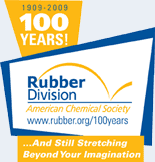![[ Visit ACS Rubber Website ]](images/logo.jpg) |
|
Centennial Elite SponsorsBecome a Centennial Elite Sponsor |
Green Polymer Chemistry: Synthesis and Characterization of Novel Dendritic Biomaterials using Enzyme CatalysisWednesday, October 14, 2009
Concourse A & B (David L. Lawrence Convention Center )
Polyisobutylene- and siloxane-based rubbery biomaterials are attractive because of their inertness in the human body.1 Our group successfully functionalized polyisobutylene (PIB) and poly(dimethyl siloxane) (PDMS) with vinyl methacrylate by transesterification using Candida antarctica lipase B (CALB, Novozyme 435) as the enzyme catalyst.2-4 Our goal is to design well-defined star and dendritic nanostructures, which are applicable as theranostic (therapeutics combined with diagnostics) agents for drug delivery.
This paper will discuss the synthesis and characterization of model structures based on tetraethylene glycol (TEG). TEG was reacted with 2-(acryloyloxy)ethyl vinyl adipate (VA), a hetero-functional linker also made by enzyme catalysis, to quantitatively yield TEG-diacrylate. (HO)2-TEG-(OH)2 was then successfully prepared by Michael addition of diethanolamine to TEG diacrylate catalyzed by CALB. The (HO)2-TEG-(OH)2 core was then extended repeating the same sequence of reactions. The reactions were monitored by Thin Layer Chromatography. The structure of the reactants and products was characterized by 1H and 13C nuclear magnetic resonance (NMR) spectroscopy, and electrospray ionization mass spectrometry (ESI MS). The same method will be used to synthesize PIB- and PDMS-based dendrimers. References 1. Puskas, J. E.; Chen, Y. Biomacromolecules, 2004, 5, 1141–1154. 2. Puskas, J. E.; Sen, M. Y.; Seo, K. S. J. Polym. Sci. Part A: Polym. Chem., Highlight, 2009, 47, 2959-2976. 3. Sen, M. Y.; Puskas, J. E.; Ummadisetty, S.: Kennedy, J. P. Macromol. Rapid Commun., 2008, 29, 1598–1602. 4. Puskas, J. E.; Sen, M. Y.; Kasper, J. R. J. Polym. Sci. Part A: Polym. Chem., 2008, 46, 3024-3028. |









